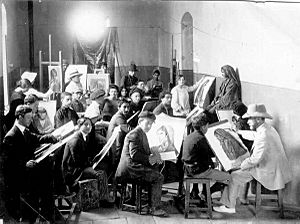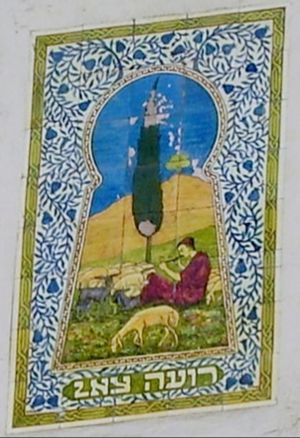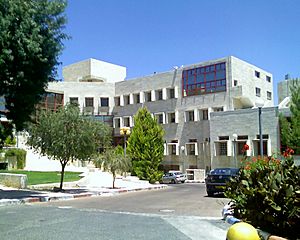Bezalel Academy of Arts and Design facts for kids
|
בצלאל, אקדמיה לאמנות ועיצוב
|
|
 |
|
|
Former names
|
Bezalel School |
|---|---|
| Type | Public college Art school |
| Established | 1906 |
| Founder | Boris Schatz |
| President | Adi Stern |
| Students | 2,500 |
| Undergraduates | 2,200 |
| Postgraduates | 300 |
| Location |
Jerusalem, Israel
31°46′54″N 35°13′24″E / 31.7818°N 35.2234°E |
| Campus | Urban |
Bezalel Academy of Arts and Design (Hebrew: בצלאל, אקדמיה לאמנות ועיצוב) is a famous public college for art and design in Jerusalem, Israel. It was started in 1906 by a Jewish artist named Boris Schatz. Bezalel is the oldest higher education school in Israel. Many people think it is the best art school in the country.
The school is named after a person from the Bible, Bezalel, son of Uri. He was chosen by Moses to design and build the Tabernacle. The art made by Bezalel's students and teachers in the early 1900s helped start Israeli visual arts in the 20th century.
Bezalel's main campus is very large, about 460,000 square feet. It is located near the Russian Compound in the center of Jerusalem. The architecture department is still at Bezalel's older, historic campus nearby.
As of 2023, Bezalel offers ten different bachelor's degrees and five master's programs. More than 500 teachers work there, and about 2,500 students attend. This includes 2,200 undergraduate students and 300 graduate students.
The school has won many awards. These include 14 Israel Prizes and 3 EMET Prizes.
Contents
The Story of Bezalel: How It Began
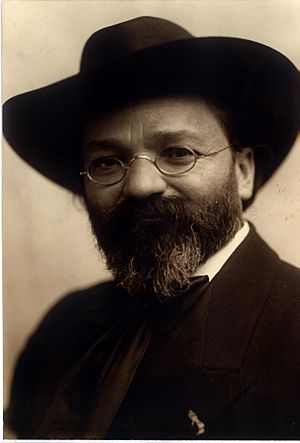

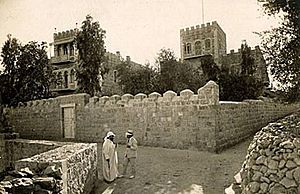
In 1903, Boris Schatz had an idea to start an art school. He talked about it with Theodor Herzl, who was a very important leader in Zionism. Schatz wanted to create a special style of art for Zionism. This style would mix old Jewish and Middle Eastern art with European traditions.
In 1905, a big meeting called the seventh World Zionist Congress agreed to support starting a Zionist art school in Ottoman Palestine. The Bezalel School of Arts and Crafts officially opened in 1906. E.M. Lilien also helped to start it.
The school first opened in rented rooms on Ethiopia Street in Jerusalem. Later, it moved to a group of buildings that were built in the 1880s. These buildings had stone walls with a special top edge, like a castle. In 1907, the Jewish National Fund bought the property for Boris Schatz. Schatz lived on the campus with his family.
The first class at Bezalel had 30 young art students from Europe. They all passed an entrance exam to get in. Eliezer Ben Yehuda was hired to teach them Hebrew. This was important because the students came from different countries and did not have a common language. His wife, Hemda Ben-Yehuda, worked as Boris Schatz's secretary.
Besides traditional painting and sculpture, the school also had workshops. Here, students made beautiful art objects from silver, leather, wood, brass, and fabric. Many of the skilled workers were Yemenite Jewish silversmiths. They had a long history of working with precious metals. This was a common job for Jewish people in Yemen. Artists at Bezalel often drew or painted Yemenite immigrants.
Many students from Bezalel became famous artists. Some of them include Meir Gur Aryeh, Ze'ev Raban, Shmuel Ben David, Ya'ackov Ben-Dov, Zeev Ben-Zvi, Jacob Eisenberg, Jacob Pins, Jacob Steinhardt, and Hermann Struck. In 1912, there was one female student, Marousia (Miriam) Nissenholtz, who used the name Chad Gadya.
Reopening and Growth
Bezalel closed in 1929 because it had money problems. After Adolf Hitler came to power, Bezalel's leaders asked Josef Budko to reopen the school. Budko had left Germany in 1933. The New Bezalel School of Arts and Crafts opened in 1935. Many teachers and students from Germany came to the school. Many of them were from the Bauhaus school, which the Nazis had closed. Budko asked Jakob Steinhardt and Mordecai Ardon to teach there. Both of them later became directors of the school.
In 1958, Bezalel won the Israel Prize for painting and sculpture. This was the first year the prize was given to an organization.
In 1969, Bezalel started getting money from the government. In 1975, the Council for Higher Education in Israel recognized it as a school for higher education. The school moved to Mount Scopus in 1990.
In 2013, some programs moved to the Hansen House complex in Jerusalem. These included the Master's Program in Industrial Design. Later, other master's programs also moved there.
In 2009, Bezalel announced plans to move to a new campus. This campus is next to the Russian Compound. This move was part of a city plan to make Jerusalem's downtown lively again. The new campus, called the Jack, Joseph and Morton Mandel campus, opened in 2023. It was designed by a famous architectural firm from Tokyo called SANAA. They worked with Israeli firms Nir Kutz Architects and HQ Architects.
Bezalel Pavilion: A Special Shop
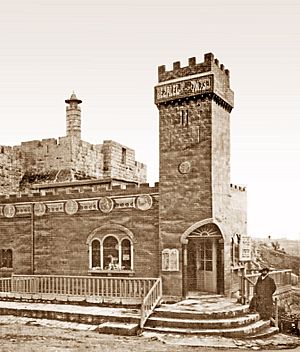
The Bezalel pavilion was a small building made of wood and covered with tin. It had a roof like a castle and a tower. It was built in 1912 outside Jaffa Gate. This building was a shop and a place to show off souvenirs made by Bezalel. The British authorities tore down the pavilion six years later.
The Bezalel Art Style
Bezalel created a special art style known as the Bezalel school. This style showed stories from the Bible and Zionist ideas. It was influenced by European jugendstil (also called Art Nouveau) and traditional art from Persia and Syria.
Artists mixed different ideas from their surroundings, old traditions, and new ideas. They used themes from the Bible, Islamic designs, and European art styles. They did this to create a unique Jewish art style for the new nation they wanted to build in the ancient Jewish homeland.
Ceramic Tiles: Art on Buildings
In the 1920s, the Bezalel School made decorative ceramic tiles. These tiles showed pictures of people and scenes from the Bible or Zionist history. Some of these tiles can still be seen today. In Tel Aviv, some well-known examples are:
- Lederberg House (built 1925) at the corner of Allenby Street and Rothschild Boulevard. The ceramic tiles were designed by Ze'ev Raban.
- Moshav Zkenim Synagogue, located at 89 Allenby Street.
- Municipal School, at 37 Ahad Ha'Am Street (built 1924).
- Bialik House, also known as Beit Bialik.
There are also Bezalel-made ceramic street signs that still exist in Jerusalem.
Bezalel Today
In 2006, the Bezalel Academy of Art and Design celebrated its 100th birthday. Today, it has many different departments. These include Fine Arts, Architecture, Ceramic Design, Industrial Design, Jewelry, Photography, Visual Communication, Animation, Film, and Art History & Theory.
Bezalel offers several types of degrees:
- Bachelor of Fine Arts (B.F.A.)
- Bachelor of Architecture (B.Arch.)
- Bachelor of Design (B.Des.)
- A Master of Fine Arts (M.F.A.) in partnership with Hebrew University
- Two different Master of Design (M.Des.) degrees
- A Master of Arts (M.A.) in Theory and Policy of art
In 2011, Bezalel students showed their work at the Milan Furniture Fair. Their exhibit was called a "lively runner-up" for the best display there.
Talented People: Teachers and Graduates
Notable Faculty
- Samuel Hirszenberg (1865–1908), painter
- Yaacov Kaufman (born 1945), industrial designer
- Aaron Marcus, (born 1943), graphic designer and computer artist, Visiting Faculty, 1977–78
- Abraham Neumann (1873–1942), painter
- Abel Pann (1883–1963), painter
- Ze'ev Raban (1890–1970), painter, decorative artist, and industrial designer
- Siona Shimshi (born 1939), painter, sculptor, ceramist, and textile designer
- Sari Srulovitch (born 1964), artist and silversmith
- Joshua Neustein (born 1940), contemporary visual artist
Notable Alumni
- Noor Abuarafeh (born 1986), Palestinian visual artist
- Baruch Agadati (1895–1976), Russian-Palestinian-Israeli classical ballet dancer, choreographer, painter, film producer and director
- Yaacov Agam (born 1928), sculptor and experimental artist
- Gideon Amichay (born 1963), communication artist, cartoonist, writer
- Ron Arad (born 1951), industrial designer
- Avigdor Arikha (1929–2010), painter
- Netiva Ben-Yehuda (1928–2011), author, editor, Palmach commander
- Moti Bodek (born 1961), architect, lecturer
- Elinor Carucci (born 1971), photographer
- Yitzhak Danziger (1916–1977), sculptor
- Hanna Eshel (1926–2023), sculptor
- Uri Gershuni (born 1970), photographer
- Yoni Goodman (born 1976), animator and illustrator
- Nachum Gutman (1898–1980), painter, sculptor, author
- Na'ama Haneman, silversmith
- Vania Heymann (born 1986), film director
- Nir Hod (born 1970), artist
- Anat Hoffman (born 1954), executive director of Israel Religious Action Center and director and founding member of Women of the Wall
- Itshak Holtz (born 1925), painter
- Gurwin Kopel (1923–1990), artist
- Brothers of Light (born 1988 and 1991), street artists
- Yaron London (born 1940), media personality, journalist, actor, songwriter
- Joshua Meyer (born 1974), painter
- Rutu Modan (born 1966), illustrator, comic book artist
- Roy Nachum (born 1979), contemporary artist
- Itay Noy, watchmaker
- Ran Poliakine (born 1967), serial entrepreneur
- Zvi Raphaeli (1924–2005), painter and Rabbi
- Ophrah Shemesh (born 1952), painter
- Avigdor Stematsky (1908–1989), painter
- Yehezkel Streichman (1906–1993), painter
- Lidia Zavadsky (born 1937), sculptor
See also
 In Spanish: Academia de artes y diseño Bezalel para niños
In Spanish: Academia de artes y diseño Bezalel para niños
- Jewish ceremonial art
- List of Israeli visual artists
- List of universities and colleges in Israel


